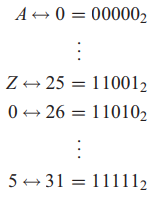Understanding Cryptography by Christof Paar and Jan Pelzl - Chapter 2 Solutions - Ex2.11
- 7 mins- Return to index
- Exercise 2.1
- Exercise 2.2
- Exercise 2.3
- Exercise 2.4
- Exercise 2.5
- Exercise 2.6
- Exercise 2.7
- Exercise 2.8
- Exercise 2.9
- Exercise 2.10
- Exercise 2.11
- Exercise 2.12
Exercise 2.11
We want to perform an attack on another LFSR-based stream cipher. In order to process letters, each of the 26 uppercase letters and the numbers 0, 1, 2, 3, 4, 5 are represented by a 5-bit vector according to the following mapping:

We happen to know the following facts about the system:
- The degree of the LFSR is \(m = 6\).
- Every message starts with the header WPI.
We observe now on the channel the following message (the fourth letter is a zero):
j5a0edj2b
- What is the initialization vector?
- What are the feedback coefficients of the LFSR?
- Write a program in your favorite programming language which generates the whole sequence, and find the whole plaintext.
- Where does the thing after WPI live?
- What type of attack did we perform?
Solution
This solution is verified as correct by the official Solutions for Odd-Numbered Questions manual.
1. The first thing we need to do is convert the chosen plaintext “WPI” into binary:
10110 01111 01000
We next need the first three latters of ciphertext converted into binary:
01001 11111 00000
To extrapolate the keystream that encrypted our chosen plaintext, we simply XOR the two:
11111 10000 00100
Given that we know the degree of the LFSR is 6, then the first 6 bits of the keystream must be the initialisation vector:
111111
2. To derive the feedback coefficients, we can exploit our knowledge of \(2m\) bits of keystream:
The following simultaneous equations can be used to derive the feedback coefficients \(p_i\):
\[s_5p_5 + s_4p_4 + s_3p_3 + s_2p_2 + s_1p_1 + s_0p_0 = s_6\] \[s_6p_5 + s_5p_4 + s_4p_3 + s_3p_2 + s_2p_1 + s_1p_0 = s_7\] \[s_7p_5 + s_6p_4 + s_5p_3 + s_4p_2 + s_3p_1 + s_2p_0 = s_8\] \[s_8p_5 + s_7p_4 + s_6p_3 + s_5p_2 + s_4p_1 + s_3p_0 = s_9\] \[s_9p_5 + s_8p_4 + s_7p_3 + s_6p_2 + s_5p_1 + s_4p_0 = s_{10}\] \[s_{10}p_5 + s_9p_4 + s_8p_3 + s_7p_2 + s_6p_1 + s_5p_0 = s_{11}\]If we plug in our known values for \(s_i\) then we can express this as the following augmented matrix and perform Gauss-Jordan Elimination:
The matrix is now in reduced row echelon form, and the values \(p_i\) can be read directly from the matrix:
3. I wrote a python script which can perform many of the operations involved in this attack:
Note: This is not a remotely efficient implementation of an LFSR-based Stream Cipher.
import string, re
def bit_encoding_map():
return zip(string.ascii_lowercase + string.digits, range(0, 32))
def bitencode(text):
def encode_char(c):
map = dict(bit_encoding_map())
return bin(map[c.lower()]).lstrip("-0b").zfill(5)
return "".join([encode_char(c) for c in text])
def bitdecode(text):
def decode_block(bits):
map = dict([(b, a) for a, b in bit_encoding_map()])
return map[int(bits, 2)].upper()
return "".join([decode_block(bits) for bits in re.findall(".{1,5}", text)])
# This was discovered by performing Gaussian Elimination on the discovered keystream
# There is a generalised algo for solving Guassian Elimination that could have produced
# this function in an automated way
def lfsr(init_vector):
registers = list(bin(init_vector).lstrip("-0b").zfill(6)[-6:])
while True:
registers.insert(0, "1" if registers[-1] != registers[-2] else "0")
yield registers.pop()
def xor_bitstream(a, b):
return "".join(["1" if a != b else "0" for a, b in zip(a, b)])
def apply_keystream(lfsr_init_vector, text):
return bitdecode(xor_bitstream(lfsr(lfsr_init_vector), bitencode(text)))
def print_ciphertext_and_chosen_plaintext(ciphertext, chosen_plaintext):
print "\n==========="
print "Ciphertext:"
print "===========\n"
print ciphertext
print "\n================="
print "Chosen Plaintext:"
print "=================\n"
print chosen_plaintext
def print_keystream(keystream):
print "\n==================="
print "Revealed keystream:"
print "===================\n"
print keystream
def print_decrypted_message(plaintext):
print "\n==================="
print "Revealed plaintext:"
print "===================\n"
print plaintext, "\n"
if __name__ == "__main__":
ciphertext = "j5a0edj2b"
chosen_plaintext = "WPI"
lfsr_init_vector = 63
keystream = xor_bitstream(bitencode(ciphertext), bitencode(chosen_plaintext))
plaintext = apply_keystream(lfsr_init_vector, ciphertext)
print_ciphertext_and_chosen_plaintext(ciphertext, chosen_plaintext)
print_keystream(keystream)
print_decrypted_message(plaintext)The code above can do everything except perform the Gauss-Jordan Elimination to find the coefficients. This I did by hand. However, since a general algorithm exists, then there’s no reason the code couldn’t be extended to perform the full attack.
The full plaintext is revealed as:
WPIWOMBAT
3. The wombat is an animal that lives in Tasmania and South-Eastern Australia.
4. We performed a known-plaintext attack.
